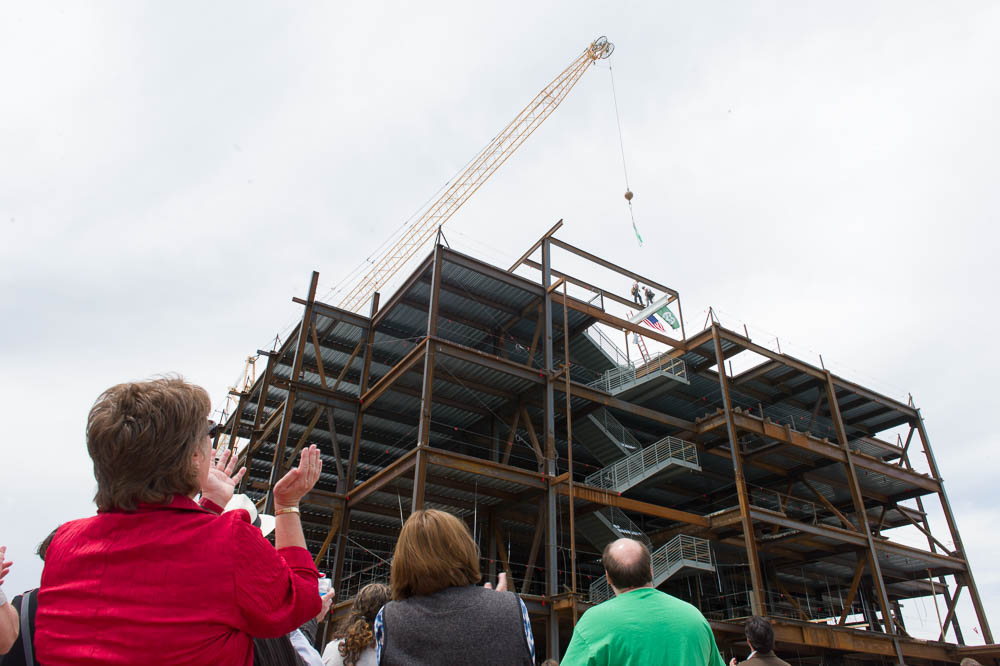
What a difference a year makes.
Last fall when new and returning students arrived on campus, several construction projects – the Biology and Chemistry Research buildings, the CSU Health and Medical Center, on-campus stadium, Prospect Road underpass, and a second parking garage – were either in the early stages of construction or in the queue. Those six projects along with five others, dubbed “Ocean’s Eleven” by Facilities Management staff, represent the most intense period of new construction in 50 years.
While a buzz of construction activity continues , it’s a different landscape that greets students this week. As they make their way around the south end of main campus, they’ll see big change on the horizon. CSU is now more than halfway through the $700 million, three-year building boom that is transforming campus and creating exciting new spaces for living, learning, and discovery.
Behind it all is an expert Facilities Management architectural and project management team who is building success through innovative thinking. They are masterfully choreographing multiple construction projects, and skillfully managing thousands of complex, moving parts. But it hasn’t been easy.
“The biggest challenge has been the number of substantial projects at the same time and the amount of coordination among them,” said Fred Haberecht, assistant director of Facilities Management. “It’s a big, logistical challenge to coordinate and procure such a diverse portfolio of projects: from housing and athletics to classroom and research space.”
Thinking differently: the Design-Build approach
CSU lead architect Mike Rush knew that if the team was going to succeed in managing that diverse portfolio of projects, they had to adopt a new delivery process that could save time, because time was going to be expensive.
“We began monitoring industry publications and interviewing a lot of people as far back as 2013 to gauge what costs we would incur over three years with construction set to begin in 2015,” said Rush. “We found we were looking at a projected cost escalation of 4 to 8 percent each year. The solution was a delivery method that could accelerate the overall development schedule.”
If Rush and his team could cut the development schedule on a project, they could dramatically decrease the cost of construction and deliver more value to campus. But that would mean changing practices, building stronger teamwork with contractors, communicating better behind the scenes, and cultivating a willing partner in the campus community.
Rush spent months consulting with industry experts on a project delivery system known as design-build, a process he was familiar with from his years working in commercial construction. With design-build, all architectural design and construction services are single-sourced through one contractor whose team works in close collaboration with the client throughout the project. The more traditional (and time-consuming) option is design-bid-build, where an architect is hired to design plans and those plans are put out for bid by a separate build contractor. Design-build can shave a year off a project from inception to completion.
CSU Facilities Management decided to use design-build on several of the larger “Ocean’s Eleven” projects (minus the stadium and chemistry building). It was a bold experiment for a university and it worked well, producing notable rewards:
- The team pushed the boundaries of their knowledge, expanding their expertise around a new process.
- Buildings are going up faster, smarter and at less expense without sacrificing quality or campus character.
- Every structure using design-build is on time and on budget, including the Aggie Village North apartments that welcomed more than 900 students during Move-In.
Although design-build is more commonly used in commercial ventures, bridges and highway construction, and quick rebuilding following natural disasters, Rush said it is rarely used by universities and certainly “not as robustly or successfully as it was by CSU.” Getting buy-in wasn’t a hard sell.
“The university community had faith in us and they were on board,” Rush said. “It was really gratifying because there was so much trust from the beginning based on the history of the planning, designing and construction team at CSU who had just come off the successful completion of another $700 million in projects that ended in 2014. ”
Ram pride abounds
The architectural and project management team itself also had to have faith that the design-build method would work for CSU.
“When we started discussing this three years ago, I was having a hard time finding true design-build projects at other universities,” said Tracey Abel, project manager for the biology building. “We had to overcome a big hurdle, but all the project managers are proud of what we’ve done. We’ve learned a lot, and we’re only going to get better.”
Cass Beitler, assistant director of capital construction and project management for CSU, said that in addition to increasing value for the university, there has been another big bonus to using design-build.
“We’ve had the pleasure of working with a lot of great design-build contractors in Colorado, and many employees on their teams have graduated from CSU’s construction management program,” said Beitler. “They have a lot of pride in what they do and in building a campus that was once home to them and will be home to other Rams into the future.”
CSU Health and Medical Center tops out at halfway point in construction
‘Final Four’ make it to halfway mark
CSU says ‘thank you’ to Chemistry Research Building crew, state of Colorado
Halfway home: CSU celebrates on-campus stadium milestone
New biology building taking shape, topped with ceremonial beam